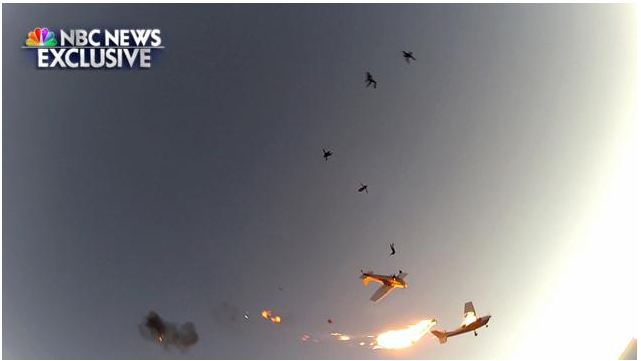Skydivers, pilots survive midair
Visit NBCNews.com for breaking news, world news, and news about the economy

Matt Fandler had no idea what hit him.
Fandler, 23, was the pilot of a Cessna 182 preparing for a formation skydive drop with a Cessna 185 in trail 12,000 feet above the airport in Superior, Wis., on Nov. 2. Fandler, in a Nov. 7 telephone interview with AOPA, recalled the moment chaos erupted, just as he was about to key the mic and announce “jumpers away.”
“It was a loud bang and the windshield immediately shattered,” Fandler said. “It came out of nowhere.”
Suddenly, Fandler was plummeting out of control. The impact and its aftermath, captured on helmet cameras, almost instantly sheared off the right wing of Fandler’s airplane, a fireball erupting from the ruptured fuel tank. All nine skydivers and both pilots on board the two aircraft escaped that fireball, and the flying debris, with their lives. Ten of the 11 people involved told their story exclusively on NBC’s Today show Nov. 5, their video—sold exclusively to NBC—going viral around the world. Fandler had his own NBC interview Nov. 6, to be aired on NBC’s Dateline.

Recalling the seconds after the Cessna 185 flown by Blake Wedan struck Fandler’s 182 from behind and above, as shown on the helmet camera footage, Fandler said it took time to get his bearings and figure out what was going on. He knew he was descending, fast, and the windshield was gone, but little else.
“Immediately I thought this is not right,” Fandler said. “I needed to try to regain control…I pulled the yoke back as far as I could. Everything was just all jumbled back and forth.”
Fandler scanned the panel and saw his airspeed and vertical speed increasing rapidly, and realized the stricken Cessna was not responding to any control input. He made a decision:
“It’s probably in my best interest not to be in this airplane anymore,” Fandler recalled. He was wearing an emergency parachute, and reached back to grab hold of something solid and pull himself toward the open door. Only then did he realize that the right-side door, and the right wing, were both absent. Gripping the empty door frame, “I took one step and just kind of jumped out of the airplane.”
Fandler had made training jumps, but this was his first solo skydive. Above him, experienced skydivers now clear of the wreckage were searching for him, accelerating their freefall in an attempt to reach the stricken Cessna, a part of the story they told NBC’s Today show on Nov. 5.
Fandler said he didn’t pull the ripcord immediately, knowing that he could wind up drifting miles away if he opened his canopy too high. He concentrated on arching his back and stabilizing his body, and worried about where his airplane would fall. Neighborhoods north and south of the airport are densely populated, he said, and he lost sight of his Cessna about five seconds after jumping out.
With no altimeter to guide the decision, he made his best guess and grabbed the ring at what looked like an altitude between 4,000 and 5,000 feet.
The canopy opened quickly, and Fandler realized, for the first time, that both of his hands had been badly cut. With no means to steer his round emergency parachute, he drifted down toward the approach end of Runway 14 at Richard I. Bong Airport, where the skydiving flight had begun.
Fandler began flying for the skydive operator, Skydive Superior, in May, he said, his first paid gig as a pilot, though he previously gained experience working with another operator. Fandler said he has flown well over 100 drops, including a few formation drops, though the Nov. 2 mission was his first formation drop with Skydive Superior.
Circling above, Wedan was still able to control his Cessna 185, though it, too, had been significantly damaged. Wedan told NBC that he kept the engine at idle and scanned for canopies. Wedan would not know for sure that everyone had survived until he landed.
Fandler said he knew he was falling too fast to land squarely on his feet, and did a “kind of half somersault” as he touched the ground about 50 feet from the approach end of Runway 14. He got to his feet, unstrapped the parachute, and began to wrap his right hand, which would eventually require 21 stitches. (The wound in Fandler’s left hand needed four stitches, he said.) He saw emergency vehicles rush onto the airport grounds, and onto the runway that Wedan was preparing to land on. Fandler started to run and wave, warning the emergency vehicles to get clear, the stricken 185 now on final approach.
The skydivers, by now safely on the ground, were able to warn the emergency vehicles away in the nick of time, Fandler said. It took a few minutes before the ambulance got to him: Emergency responders looked for him first in the wreckage, which landed in the county fairgrounds just west of the airport.
All 11 pilots and passengers survived, and no one on the ground was hurt by falling aircraft pieces.
“In my opinion, that’s probably the most miraculous thing about this whole ordeal,” said Fandler. “After I jumped out, I had no control of where that airplane was going to go.”
Fandler said he has been interviewed by FAA officials acting on behalf of the NTSB, and his main concern, now, is the outcome of the federal investigation. He plans to make a career as a professional pilot, and preferred to avoid any comment about the possible cause of the accident while the investigation is under way.
Fandler said the media response took him by surprise. He expected to see a picture and a story in the local paper, but nothing like the dozens of stories that have been written since.
“I never imagined that it would go viral all over the world like it has,” Fandler said.
Skydive Superior did not immediately respond to an email seeking comment; all of those involved in the flight, except Fandler, had traveled to New York for the Nov. 5 NBC interview.
Fandler said he’s eager to fly again, and even willing to make another (planned) skydive, though he “would really prefer if it was with somebody else.”



